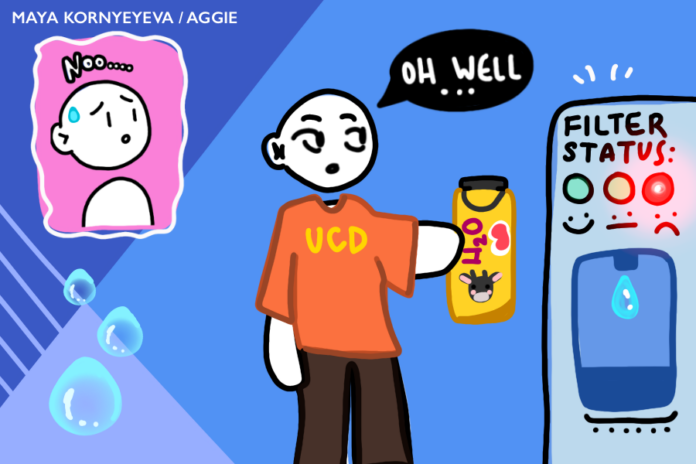Where Davis water comes from, and how to ensure it is safe to drink
By MAYA KORNYEYEVA — mkornyeyeva@ucdavis.edu
Do you know where your water comes from?
I asked around with this question, curious to see the breadth of knowledge that my peers, friends and UC Davis students in general have about our drinking water. In response, I received a lot of shrugs and some contemplation-filled pauses. A few responded with guesses: the Sacramento River, rain water, Putah Creek, to name a few.
While these guesses are not far off from the truth, it was surprising to see that so little was known about our drinking water. Seeing as water — which covers 71% of the planet and is one of the most abundant molecules on the Earth’s surface and within our cells — is crucial to our survival, not knowing what we are drinking and where it is coming from is quite concerning.
To dive deep (pun intended) into the Yolo County and Central Valley water systems, our first stop along the way is, as many guessed, the Sacramento River.
The Sacramento River runs approximately 384 miles, through the city of Sacramento and beyond. Daily, 10.2 million gallons of water are taken and processed by the Regional Water Treatment facility in Woodland to make up a significant portion (87%) of Davis city water. As the Sacramento River is categorized as “surface water” — water that is collected and trapped at the surface of the Earth — it can contain run-off sources of contamination like livestock and agricultural drainage, waste-water facilities, stormwater and urban runoff and watershed spills.
The second source that makes up the remaining 13% of the drinking water in the city of Davis is groundwater. “Groundwater” is a term used to describe water stored naturally beneath layers of soil and rock, which usually accumulates as a result of snowmelt or rain. Due to its underground location, groundwater is perceptible to naturally occurring contaminants like selenium and chromium, which are by-products of land use activities like agriculture.
According to the Annual Davis Water Quality Report (2022), our water contains a number of things besides just clean, crisp H2O. While many of the harmful substances are removed during processing, they are only removed up to the Environmental Protection Agency’s (EPA) chemical limits. Some trace amounts still remain in the water even post-processing. The Water Quality Report lists five categories of potential contaminants to be aware of, including microbial, inorganic, pesticides and herbicides, organic chemicals and radioactive contaminants.
After and during water processing, disinfectants are often used to remove these potential contaminants. A small amount of the disinfectant can get through to your drinking water. There’s no need for alarm, as the amount is substantially small; however, it is important to know what you may be drinking, besides just what we think of as “water.”
While the Davis water quality is up to standards, it is crucial to employ some at-home precautions. For instance, using a portable water filter such as a Brita is a key step to water safety. Filters often contain absorbents to remove lead and activated carbon to remove chlorine taste and odor, along with a fibrous matrix to remove small particles from your water. Moreover, they are reusable and filters can be replaced every few months to ensure your water is clean.
Another step you can take is boiling your drinking water, which is especially effective after filtering. Boiling water kills bacteria, viruses, pathogens and other protozoa that may be present in the water. In short, boiling sterilizes the water by removing any microorganisms that could prove potentially harmful to humans.
If anything, just make sure you are careful about where you are sourcing water from. Too many times I have watched students walk up to one of the water dispensers on campus, the filter status shining bright red, and refill their water bottles. A red filter status is most definitely not a good sign — this means that the water is “tap” quality, and isn’t going through any safety filters or through old, no longer functioning ones.
Water is central to our health and well-being. Therefore, taking the extra effort to filter or boil your water, avoid drinking straight from the tap or from unfiltered stations and increase your knowledge about how water is processed in Davis can help protect you from ingesting potential contaminants. Who knows, maybe next time you see someone dangerously close to drinking from a red filter station, you can be a hero.
Written by: Maya Kornyeyeva — mkornyeyeva@ucdavis.edu
Disclaimer: The views and opinions expressed by individual columnists belong to the columnists alone and do not necessarily indicate the views and opinions held by The California Aggie.




